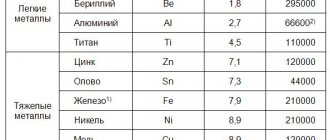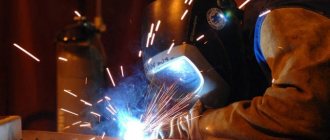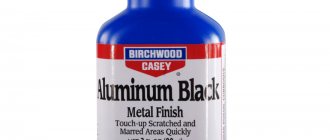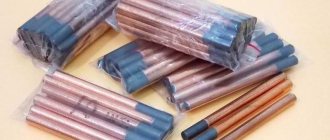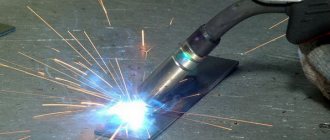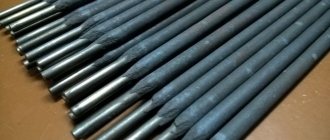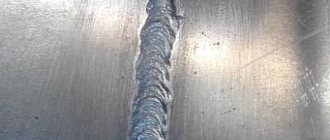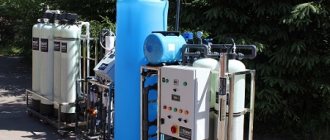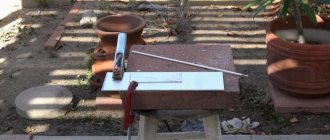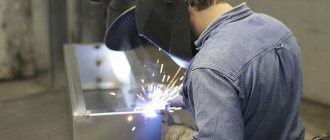DIY electrodes for welding aluminum
Aluminum electrodes for welding are metal rods coated with coating. The coating protects the metal from oxidation and improves the quality of the weld. They are practically not used in large workshops and factories, since their efficiency is not enough to perform large volumes of work. But such electrodes are widely used by home craftsmen.
A carbon electrode is often used to weld aluminum. In this article we will tell you everything you need to know about aluminum rods and explain in detail how to make your own welding electrodes.
Features of welding aluminum at home
Anyone who has welded aluminum at least once in their life knows that this is a very difficult task. There is an oxide film on the surface of the metal, which makes the welding process difficult. Do-it-yourself aluminum welding electrodes can solve this problem.
But before you start, you need to thoroughly clean the surface. Remove contaminants and carry out comprehensive preparation of the metal for welding. This will improve the quality of the seams and they will last longer.
For high-quality welding of aluminum parts, you need a welding machine that produces direct current and is connected in reverse polarity. If you are using electrodes for aluminum arc welding, then pay attention to the current strength. This parameter should be set to a small value.
Follow our recommendations to get the job done efficiently:
- If you need to weld thick parts, then the approximate location of the seam must be properly heated before welding. This is done using a regular gas burner.
- Be sure to clean the seam of slag and pour boiling water over it.
- Once the grout has cooled, clean it again using a stiff brush. Do not disregard this advice, as remaining slag can promote corrosion.
Popular brands of electrodes
As we mentioned earlier, a carbon electrode is often used to weld aluminum. But besides this, there are a number of brands that are no less popular among beginners and experienced welders. So, what electrodes can you use for welding aluminum with your own hands?
OK brand rods
These electrodes are manufactured by ESAB and are marked OK. We recommend using models 96.10, 96.20 and 96.50. Yes, they are not universal, but with their help you can weld technical aluminum or manganese-based aluminum alloys. These aluminum electrodes for welding at home have shown themselves to be on the positive side, but keep in mind that they require special care and strict adherence to the expiration date.
Rods brand OZA
In principle, such electrodes for welding aluminum with your own hands can be made, since they are based on simple aluminum wire. These rods are used for welding pure aluminum or its silicon alloys.
UANA brand rods
These are very highly directional rods used for welding cast aluminum alloys. They are practically not used in home welding, but we could not include them in our list.
EHF brand rods
EHF are tungsten electrodes; they must be used when welding with argon. It is difficult to make such electrodes for aluminum with your own hands, but if you have the opportunity to purchase them, be sure to try them in your work. Yes, with their help it is difficult to strike the arc correctly, and professionals often do not recommend such electrodes. But if you learn to hold an arc with such rods, then you will not have problems with all the others.
Manufacturing instructions
It doesn't matter what brand of electrodes you need to purchase, in any case it is not cheap. Especially for beginner welders. We have found a solution to this problem and suggest you make the rods yourself. There are many videos on the Internet in which experienced craftsmen explain the technology for making materials for welding. We also decided to share our instructions on how to make homemade electrodes with your own hands. Follow these simple steps:
- Prepare aluminum wire with a diameter of no more than 4 millimeters and cut it into rods 20-25 centimeters long. These parameters are usually sufficient, but you can change the diameter and length as you wish. Our base is ready.
- Now let's prepare the coating. Grind up chalk (preferably regular white) and mix it with silicate glue (sometimes called “liquid glass” in stores). Mix everything thoroughly until smooth and dip the aluminum rods into it.
- Make sure that the coating layer does not exceed 2 millimeters. Leave the electrodes to dry. When the coating hardens, the rod can be used for work.
Yes, such electrodes for resistance welding are inferior in quality to factory products, but they still allow you to perform simple work that does not require increased responsibility and a perfect seam. This instruction may seem too simple, but believe me, electrodes for spot welding on your own can also be effective and will absolutely save your money.
Please note that this is not a factory carbon electrode or zinc electrode, it is not European quality. So test your electrodes first before working on unwanted metal.
Instead of a conclusion
Source: https://svarkaed.ru/rashodnye-materialy/elektrody/elektrody-dlya-svarki-alyuminiya-svoimi-rukami.html
Electrodes for aluminum
Welding aluminum products is not an easy task and has its own characteristics. There is an oxide film on the surface of this metal, which introduces its own difficulties when working with this metal. Rapid oxidation of aluminum leads to the formation of a refractory film, which prevents the formation of a solid seam at the joints.
The presence of an element such as silicon in aluminum-based alloys leads to the formation of cracks between the metal crystals. The appearance of slag during process stops makes it difficult to re-ignite the arc. When hardening, the weld bead may lose its shape due to the high linear expansion coefficient.
However, homemade aluminum electrodes can cope with these problems with greater or lesser success. To obtain a high-quality seam, it is necessary that the composition of the electrode rod matches the composition of the base material. Therefore, to weld aluminum products, you should use aluminum wire as a rod for a homemade electrode.
To get a high-quality result using aluminum electrodes with your own hands, you need to thoroughly clean the surfaces of the aluminum parts to be joined. This can be done using various solvents such as technical alcohol. Alkaline baths will also help.
If you make aluminum electrodes for arc welding yourself, then when using them you need to pay attention to the value of the current set on the equipment. It should be minimal.
To get electrodes for welding aluminum with your own hands, you need to prepare a wire made of aluminum, the diameter of which does not exceed 4 millimeters, and cut it into pieces approximately 20-25 millimeters long. You can slightly adjust these values at your discretion.
Then you should start preparing the coating. To do this, carefully crushed chalk, usually white, must be mixed with store-bought silicate glue, often called liquid glass. This mixture should be stirred until a liquid consistency is obtained. Then you need to start dipping the cut rods in it one by one, leaving a small end dry. The thickness of the coating should not exceed two millimeters and this must be carefully monitored.
Next, the electrodes should be left to dry, waiting until the coating in the form of coating has firmly hardened. Calcination of homemade aluminum electrodes must be carried out for two hours at a temperature of no less than 200 degrees.
Welding with aluminum electrodes must be carried out using direct current, setting the reverse polarity on the equipment used. If you plan to weld thick-walled products, then the wire for making electrodes must be chosen with a large diameter.
Types of electrodes for aluminum and rules for quality welding
Aluminum electrodes, which are metal rods coated with a special coating, are very rarely used in large-scale production. With their help, metal is welded at home, in small enterprises, or when performing complex installation work outside the walls of the production workshop. When using such electrodes, it is possible to get rid of the oxide film on the surface of aluminum, which greatly complicates welding work performed on parts made of this metal.
How to weld aluminum with an electrode
Aluminum electrodes for welding are metal rods coated with coating. The coating protects the metal from oxidation and improves the quality of the weld.
They are practically not used in large workshops and factories, since their efficiency is not enough to perform large volumes of work.
But such electrodes are widely used by home craftsmen.
A carbon electrode is often used to weld aluminum. In this article we will tell you everything you need to know about aluminum rods and explain in detail how to make your own welding electrodes.
How to weld aluminum: description of electrode welding technology
Currently, aluminum is used in a wide variety of fields.
This thin and flexible material is often found in vehicle parts, including engine blocks, transmissions and body parts.
It is also used to create stainless steel containers for household and industrial needs and many other important everyday items.
If a crack or problematic hole forms in such a structure, it is better to close it using a special apparatus in an argon environment.
However, not every average person has such a unit at their disposal, so they have to look for more affordable solutions.
One of them is aluminum electrode welding .
To successfully carry out such an activity, it is necessary to acquire a certain set of skills and purchase the appropriate equipment and supplies. The principle and technology of such welding are quite simple, so with the right approach you can learn them in a short time.
Features of working with aluminum
Electric arcs are used to connect many types of iron.
This technique ensures a sufficiently high combustion temperature, resulting in high-quality penetration of plates of different thicknesses, creating reliable and hermetically sealed protection. However, welding aluminum using an inverter is considered the most difficult due to certain specific characteristics.
The first difficulty lies in the hygroscopic properties of the material, which can accumulate ambient moisture.
And although this cannot be noticed in a naturally cooled state, problems will certainly arise when welding begins.
When the arc is ignited and the metal is heated to elevated temperatures, moisture particles begin to evaporate from the surface and inevitably penetrate into the welding zone.
The result is excessive spatter and interference that prevents a normal seam.
To prevent this phenomenon, it is enough to preheat the structure at a temperature of 150−190 degrees Celsius. In this case, you can notice intense release of moisture on the surface .
The next difficulty is the presence of an oxide film that covers all products. Its purpose is to protect the structure from the aggressive effects of an acidic environment.
However, this makes processing with an inverter significantly more difficult. The main problem is associated with the large difference in melting temperatures.
It is known that aluminum itself begins to melt at 500 degrees Celsius, and its oxide at 2000 degrees.
To eliminate such a difference, it is enough to clean the welding site with an iron brush to ensure the required access to the metal .
Interaction with the environment ensures the correct formation of pores in the joint structure, which significantly worsens the tightness. To protect the weld pool, argon or a gas cloud is used during inverter welding.
It is no secret that pure aluminum is practically not used for the manufacture of parts, so the fillers and additional elements included in its composition can become a problem.
For example, grades Al2 and Al2 contain silumin from 4 to 13%, so they are usually called limitedly weldable.
Similar indicators are typical for models AM r 1 and Amr 6, where manganese is added in a proportion of 2−6%.
Stages of welding activities
Understanding the key intricacies of aluminum welding is not as difficult as it might seem at first glance.
Source: https://steelfactoryrus.com/kak-svarit-alyuminiy-elektrodom/
Rods grade ok
These electrodes are manufactured by esab and the ok marking is a special feature of them. we recommend using models 96.10, 96.20 and 96.50. Yes, they are not universal, but with their help you can weld technical aluminum or manganese-based aluminum alloys. These aluminum electrodes for welding at home have shown themselves to be on the positive side, but keep in mind that they require special care and strict adherence to the expiration date.
The first recipe. How to make a welding electrode
This technology requires a lot of time and some materials (which, like normal electrodes, you may not have). Therefore, although this method exists, in my opinion... while you make these homemade electrodes... you can get hold of factory ones.
Nevertheless... In case you find it useful:
To make electrodes according to the first recipe, you will need:
- steel wire of the appropriate diameter (2, 3, 4, 5 or 6 mm.)
- liquid glass
- chalk or... paper
Mix 2 parts liquid glass with one part chalk. Dip the wire into a bath of this solution, leaving 3 centimeters of the surface uncovered (for fastening in the holder). Remove from the bath and hang on a wire to dry.
After a few minutes, when the solution begins to dry out a little, additionally “roll” your electrode in chalk.
Complete drying time is about 20-30 minutes. After this, you need to calcinate the electrode in an oven at a temperature of 110 degrees.
As you probably already guessed, you shouldn’t count on high technological performance from such a homemade product. You cannot make a high-quality seam with such an electrode. But if you are satisfied with working with tacks, this electrode is what you need!
Instead of chalk, you can use... paper! Soak ordinary newspaper in liquid glass and... wrap it around the wire in 5-6 layers. This option is considered more successful than the previous one. It is assumed that when the paper burns near the arc, the carbon dioxide released from the combustion will protect the molten bath from oxygen.
DIY electrodes for aluminum
Aluminum electrodes for welding are metal rods coated with coating. The coating protects the metal from oxidation and improves the quality of the weld. They are practically not used in large workshops and factories, since their efficiency is not enough to perform large volumes of work. But such electrodes are widely used by home craftsmen.
A carbon electrode is often used to weld aluminum. In this article we will tell you everything you need to know about aluminum rods and explain in detail how to make your own welding electrodes.
What electrodes to use for aluminum welding
Are you interested in what aluminum electrodes exist for electric arc welding and shielding gases? Let's talk about industrial and homemade rods!
